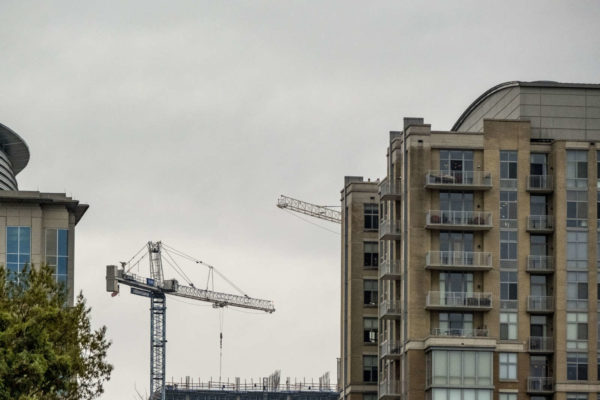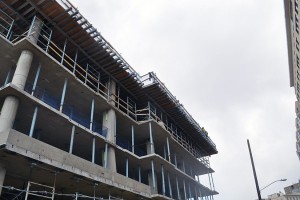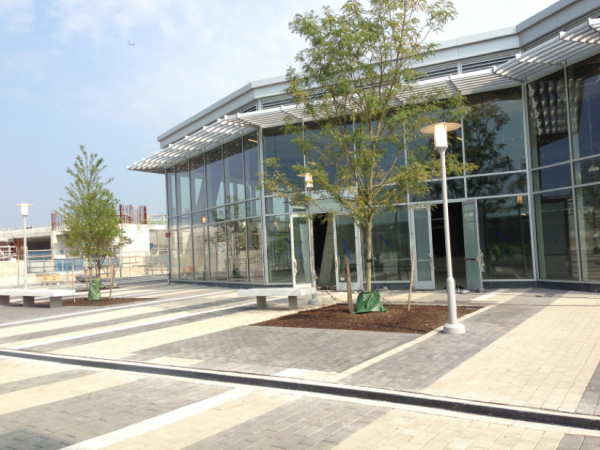
The Reston Comprehensive Plan Study Task Force is on schedule to finish its review of the document that guides planning and development in Reston this summer, Hunter Mill District Supervisor Walter Alcorn’s office announced yesterday (Thursday).
After wrapping up its review, the task force will hold town hall meetings and convene with various stakeholders, including homeowners’ associations, business groups, and community organizations, to share its recommendations and solicit public feedback.
Alcorn initiated the review process in January 2020 with the goal of updating Reston’s Comprehensive Plan to more effectively manage growth and development in Reston. The 32-member task force, which Alcorn chairs, officially kicked off their review in May and has held more than two dozen meetings since then.
Topics that have been considered by the task force as part of its review include planning principles, population and density, transportation, parks and open space, affordable housing, public health, energy and the environment, equity, and public art.
Alcorn expressed enthusiasm about the work by the community members on the task force so far, even though the schedule has been “somewhat slowed” by the COVID-19 pandemic. The task force is being supported by county staff from the planning and transportation departments, among others.
“I am very excited by the work and the collaboration by the task force,” Alcorn said. “…We still have several months of work ahead, but I believe the outcome will reaffirm Restonians’ decision to live in a planned, equity-focused community.”
The task force will hold its 16th meeting on March 22 from 7:30-9:30 p.m.
Reston Comprehensive Plan Study Task Force is scheduled to wrap up its review process this summer following a yearlong effort and 2 dozen+ meetings. Recommendations will then be shared for feedback at town hall mtgs & w/community groups. More: https://t.co/okMFan8hDI #HunterMill pic.twitter.com/bAxOU30qJb
— Supervisor Walter Alcorn (@WalterAlcornFFX) March 11, 2021
Staff Photo by Jay Westcott
The Reston Comprehensive Task Force heard from a panel of community leaders from various organizations about on how to plan for open space and public art during a meeting earlier this week
The 32-member task force is chaired by Hunter Mill District Supervisor Walter Alcorn to review and make recommendations for Reston’s Comprehensive Plan. The group, which met on Monday, includes representatives from community organizations and various backgrounds.
Alcorn asked the task force as a whole to consider its recommendations for guidance on how to treat open spaces, including what percentage of public or private-public space should be aimed for. Alcorn requested that the group consider reviewing general accessibility for open space, maintenance responsibilities, and gathering a broader sense of placemaking for open spaces.
“The issues that we’re talking about here tonight are typically not ones that are addressed, if at all, very much in a comprehensive plan,” Alcorn said Monday night. “Most of the open space issues where they’re addressed are addressed in terms of recreation use, in terms of trees saved, in terms of more what I would call them traditional open space issues.”
The topic of open space was addressed by a panel that included Larry Butler from Reston Association (RA), Robert Goudie from Reston Town Center Association (RTCA), Diana Smith from Herndon Reston Indivisible, and Abby Dunner and Tom Barnett from Fairfax County’s Office to Prevent and End Homelessness (OPEH).
Butler opened the discussion with a question for the task force and panelists to consider about the different operations between private open space and “truly open space.” He listed potential concerns in the difference of private corporations and true public entities, namely in the different protections and risks each has to consider.
Goudie followed up by listing the benefits of private ownership of open spaces and how it has impacted the RTCA, which has both a commercial and a residential partnership. His listed benefits included:
- Public treasury can struggle to fund required maintenance and upgrades that private funds can more easily handle.
- Private ownership can protect or preserve some space in the community free of political activity.
- Privatization can provide flexibility and limited bureaucracy in closing streets and creating events.
He used a few examples to clarify his position with the costs associated with the Mercury Fountain Plaza, Town Square Park, and West Market Stormwater Pond. Butler itemized the costs associated with the maintenance and renovation of each to demonstrate the private association’s ability to directly prioritize renovations and repairs that he assessed would quickly run up costs on the public coffers.
Smith also touched on the issue of public space available for political activities. She raised issues during her presentation about the hindrance created by the lack of public open spaces for those activities. She also advocated for the consideration to use the new Reston Regional Library redevelopment as a kick-start to reclaim the rights for publicly open space.
“If the Reston open space plan is successful, in my opinion, there will be no more ceding of Fairfax open space land to developers,” Smith said. “The community will be the owners and managers of our public open space, and we will have democratically selected places we can go.”
Barnett presented the final part of the open space panel as he urged the task force to also recognize the challenges created for the homeless or unsheltered population by the type of public properties in the area.
During the second panel, Leila Gordon from Public Art Reston (PAR), Lisa Mariam from ArtsFairfax, and Jaynelle Hazard from GRACE curated the discussion on public art.
The trio gave various examples to support the continued introduction of public art in the area.
“It will be vital, I think, for whatever revisions you come up with to the Reston Master Plan, that you continue to support and endorse a robust presence for public art,” Gordon said to the task force.
Mariam and Hazard also encouraged the task force to consider strengthening the language supporting public art by describing art as beneficial to the community’s identity and overall wellbeing.
Gordon added that it is critical to recognize the cost associated with commissioning and creating public art projects as well as maintaining the collection.
“You can’t expect that significant public art can be realized without multiple funding resources,” Gordon said. “You need to support the notion of funding from the public coffers, funding from the private sector, funding through the development process through specific proffers for public art amenities, and funding from individuals and community resources.”
The task force’s next meeting is on Jan. 11.
The Fairfax County Planning Commission is slated to revisit on Thursday the amendments to the county master plan that will affect development around Reston’s transit stations.
The planning commission held a public hearing in November, in which it heard testimony from dozens of Reston residents, developers and business owners on the future of Reston. It also, of course, has had nearly two months to go over the 183-page comprehensive plan amendment.
At its Thursday evening meeting, the planners will decide whether to recommend sending the plan to the Fairfax County Board of Supervisors for final approval or advise more changes. The plan is tentatively scheduled to go before the Board of Supervisors on Jan. 23.
Meanwhile, Development-watchers Reston2020 point out that county planners have made changes to the language throughout the plan amendment. Some of the the biggest criticisms from the citizens’ group is that the changes say bonus density would be allowed more than one-quarter of a mile from Metro stations and no limits on building heights.
After four years of work, the Reston Master Plan Special Study Task Force recently completed the comprehensive plan amendment — a massive document outlining everything from density around three Metro Silver Line station’s to street patterns to recreational facilities. Dozens of citizens spoke at the public hearing with a variety of opinions on the plans.
One of the main points of the plan: where to put the people. The plan calls for ratios of 50 percent commercial/residential within one-quarter mile of the Metro stations at Wiehle-Reston East, Reston Parkway and Herndon-Monroe. In the half-mile range, the ratio should be 75 percent residential, 25 commercial.
The concept of implementation — just how the plan will be executed, who will pay and other details — came up often in citizen testimony at the public hearing.
“Planning without implementation is empty,” said Reston Citizens Association President Colin Mills. “It is not just a planning issue, it is a political issue. We support having a single entity responsible for implementation issues.”
Planning commission member James Hart reminded Mills, and the people assembled a the public hearing on Nov. 13, that implementation specifics don’t need to be in place as the new Reston will evolve over 30 years and planning will get more specific when variables such as developer proffers, population growth and economic climate are known.
“The comprehensive plan regulates nothing, ” he said. “In Virginia, we are under the Dillon Rule. It is probably inappropriate to put things in the plan like specifics if they have no force of law. The plan is intended to be a general guide. If we bear that in mind a lot of what is in this plan looks a lot better.”
Read more from the public hearing here.
More:
Comprehensive Plan Goes to Planning Commission, With Caveats and Complaints
 After years of discussion and 10 drafts, the Reston Master Plan Special Study Task Force‘s comprehensive plan amendment will finally go before the Fairfax County Planning Commission Wednesday at 8:15 p.m.
After years of discussion and 10 drafts, the Reston Master Plan Special Study Task Force‘s comprehensive plan amendment will finally go before the Fairfax County Planning Commission Wednesday at 8:15 p.m.
The comprehensive plan amendment will guide Reston’s planning through the next 20-30 years, as it prepares for huge growth as a transit oriented community. The Planning Commission will decide whether to recommend the plan to the Fairfax County Board of Supervisors.
The plan allows for a variety of densities, with the greatest densities close to the upcoming Metro Silver Line stations at Wiehle-Reston East, Reston Parkway and Herndon-Monroe. But does it allow for enough green space, traffic flow and other areas of concern? Reston 2020, the Reston Citizens Association group that examines development, recently gave the plan amendments a grade of “D.”
“We felt that the plan was seriously lacking in many areas, most notably parks and recreation, transportation, and implementation,” RCA President Colin Mills wrote in an opinion piece on Reston Now two weeks ago.
Want to peruse the complex, 183-page document yourself? Visit the Department of Planning and Zoning website.



